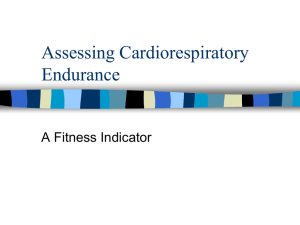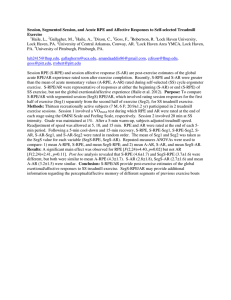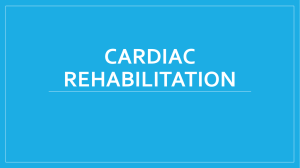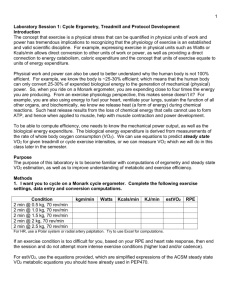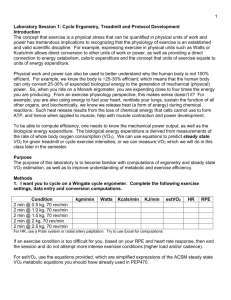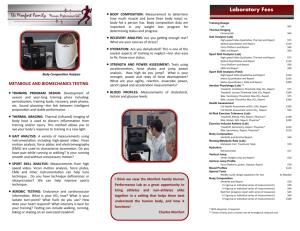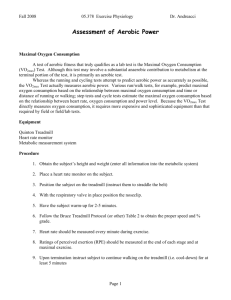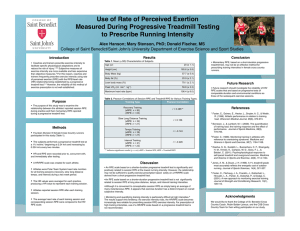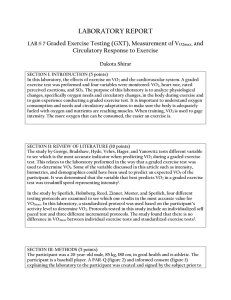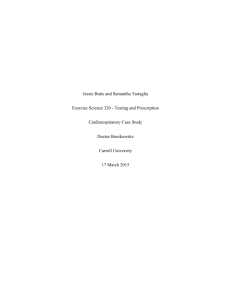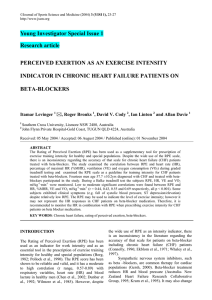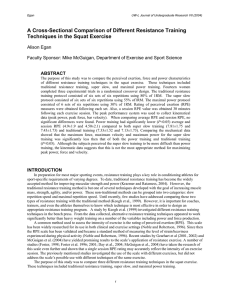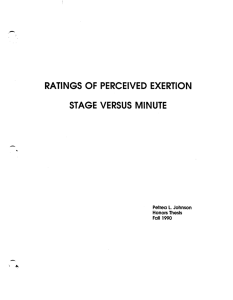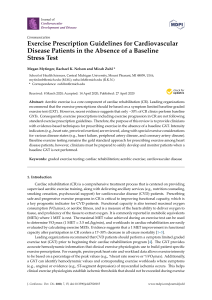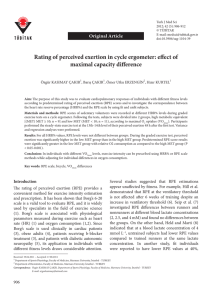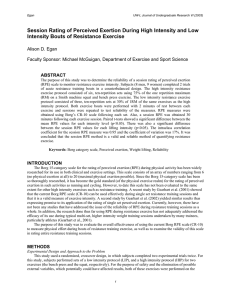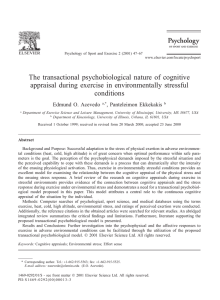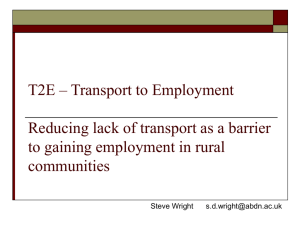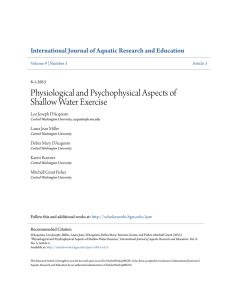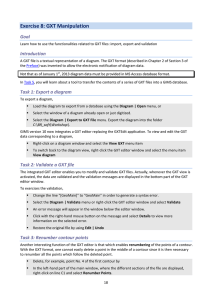Cardiorespiratory Fitness Testing
advertisement
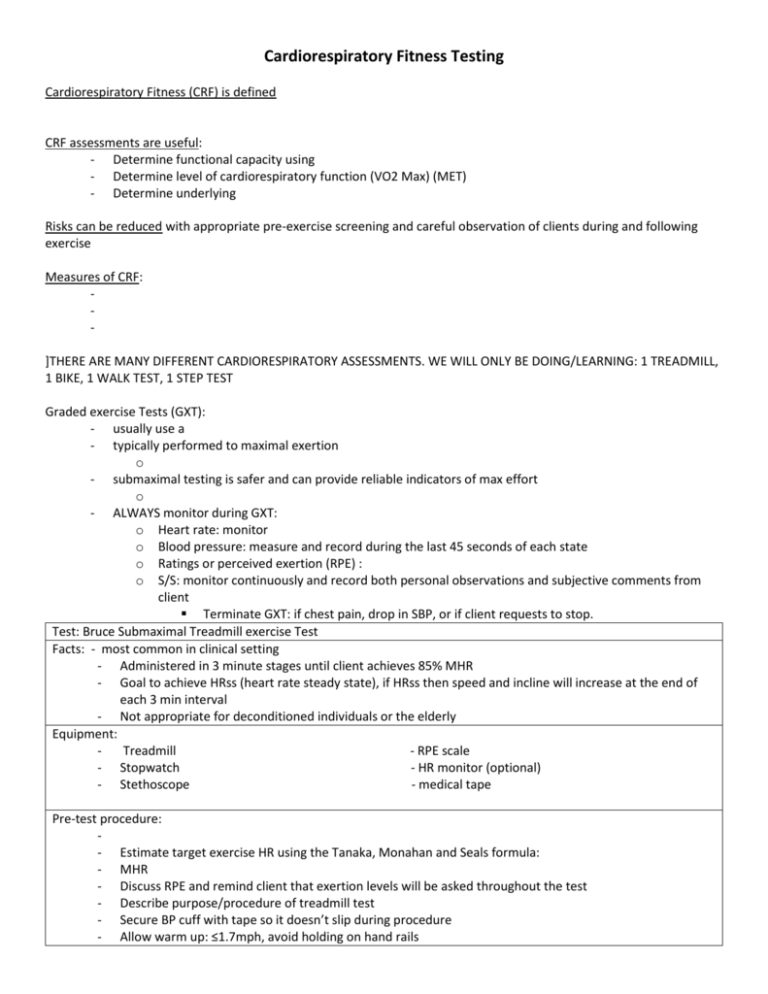
Cardiorespiratory Fitness Testing Cardiorespiratory Fitness (CRF) is defined CRF assessments are useful: - Determine functional capacity using - Determine level of cardiorespiratory function (VO2 Max) (MET) - Determine underlying Risks can be reduced with appropriate pre-exercise screening and careful observation of clients during and following exercise Measures of CRF: ]THERE ARE MANY DIFFERENT CARDIORESPIRATORY ASSESSMENTS. WE WILL ONLY BE DOING/LEARNING: 1 TREADMILL, 1 BIKE, 1 WALK TEST, 1 STEP TEST Graded exercise Tests (GXT): - usually use a - typically performed to maximal exertion o - submaximal testing is safer and can provide reliable indicators of max effort o - ALWAYS monitor during GXT: o Heart rate: monitor o Blood pressure: measure and record during the last 45 seconds of each state o Ratings or perceived exertion (RPE) : o S/S: monitor continuously and record both personal observations and subjective comments from client Terminate GXT: if chest pain, drop in SBP, or if client requests to stop. Test: Bruce Submaximal Treadmill exercise Test Facts: - most common in clinical setting - Administered in 3 minute stages until client achieves 85% MHR - Goal to achieve HRss (heart rate steady state), if HRss then speed and incline will increase at the end of each 3 min interval - Not appropriate for deconditioned individuals or the elderly Equipment: Treadmill - RPE scale - Stopwatch - HR monitor (optional) - Stethoscope - medical tape Pre-test procedure: - Estimate target exercise HR using the Tanaka, Monahan and Seals formula: - MHR - Discuss RPE and remind client that exertion levels will be asked throughout the test - Describe purpose/procedure of treadmill test - Secure BP cuff with tape so it doesn’t slip during procedure - Allow warm up: ≤1.7mph, avoid holding on hand rails Test protocol and administration: - Test begins - Assess and record - Assess and record - 3 min stages: if difference in client’s exercise HR between the 2nd and 3rd minute is >6bpm, the HR has not achieved HRss: client should continue for an additional minute at the same speed and incline - Test performed until S/S develop or until HR response exceeds 85% of MHR (needs to exceed 115bpm for at least 2 of the stages) Post test: - Cool down at moderate speed until breathing returns to normal and HR drops below 100bpm (3 to 5 min) - Calculate VO2max and MET level using following conversions - Men: 14.8 – (1.379 x time) + (0.451 x time2 ) – (0.012 x time3) = Vo2 max - Women: 4.38(time) – 3.90 = VO2 max - MET : divide VO2 max by 3.5 mL/kg/min - Record values - Continue to observe client - Compare results from using Table 8-13 Test: Rockport Fitness Walking Test (1 mile) Facts: - Purpose: - Walk - Suitable for many individuals or groups of people - Not suitable for highly conditioned clients Equipment: Track - Stopwatch - RPE chart - HR monitor with chest strap (optional) Pre-Test procedure: Explain purpose and define the course - Remind - Discuss RPE, remind them they will be asked periodically throughout the test Test protocol and administration: Record the clients weight (in kg) and age - On the trainer’s “go” the stopwatch is started and client begins - The client’s 1 mile time, RPE and immediate post-exercise heart rate are recorded on the testing form. Take HR for 15 sec then multiply by 4 - 3-5 min cool down Post test: client’s information is plugged into one of the following formulas. Females: VO2 max= 132.853 – (0.1692 x weight inkg)-(0.3877 x age) – (3.265 x walk time in min to the nearest 100th ) – (0.1565 x HR) Males: Vo2 max = 139.168 – (0.1692xweight in kg) – (0.3877 x age) – (3.265 x walk time in min to nearest 100th )- (0.1565 x HR) Evaluate client’s score using Table 8-13 and Table 8-18
